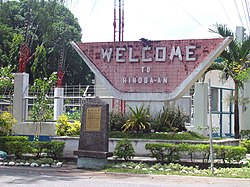Hinoba-an
| Hinoba-an | |
|---|---|
| Municipality | |

"Welcome" sign board along the highway of Hinoba-an
|
|
 Hinobaan province |
|
| Location within the Philippines | |
| Coordinates: 09°35′N 122°28′E / 9.583°N 122.467°ECoordinates: 09°35′N 122°28′E / 9.583°N 122.467°E | |
| Country |
|
| Region | Negros Island Region (NIR) |
| Province | Negros Occidental |
| District | 6th district of Negros Occidental |
| Established | November 20, 1948 |
| Barangays | 13 |
| Government | |
| • Mayor | Ernesto A. Estrao |
| • Vice Mayor | Mary Jane T. Cubid |
| Area | |
| • Total | 414.50 km2 (160.04 sq mi) |
| Population (2010) | |
| • Total | 54,624 |
| • Density | 130/km2 (340/sq mi) |
| Time zone | PST (UTC+8) |
| ZIP code | 6114 |
| IDD : area code | 34 |
| Income class | 1st class municipality |
| Website | www |
Hinoba-an (known as Asia until 1959) is a 1st class municipality in the province of Negros Occidental, Philippines. It is the southernmost town of the province. It is bounded on the north by Sipalay City and Candoni; on the south by Basay, Negros Oriental; on the east by the town of Ilog; and on the west by the Sulu Sea. According to the 2010 census, it has a population of 54,624 people.
The total land area of Hinoba-an is 421.50 square kilometers.
Hinoba-an is politically subdivided into 13 barangays, two of which comprise the town proper (or poblacion):
Formerly a part of Cauayan, Hinoba-an was inhabited by natives called "Magabat". When immigrants from Panay came and settled in the coastal areas, the settlers began to group in the area where the town is now located. Traders visited to barter products like clothing made in Miag-ao, Tigbauan and Guimbal in Iloilo.
Spanish authorities did not occupy Hinoba-an during their time in the province since the area was still a jungle. It was visited only by people from Cauayan and the neighboring towns for hunting purposes, hence no important events were recorded about the coming of the Spaniards in the town until the early 20th century.
In the early 1900s, Don Estanislao Bilbao, a Basque émigré and patriarch of the Bilbao clan---one of the area's prominent families, begun a decades-long process of settling an area south of where Hinoba-an would come to be. In a few years, a significant plot of land had been rehabilitated to which thousands of germinating coconut husks were planted in precise rows. Maturing and bearing crop in under a decade, once coastal wilderness was transformed into copra producing land. Rice fields were likewise developed further inland close to irrigation sources.
The subsequent grant of landownership, along with the total absence of government due to area's remoteness, became the basis for Don Estanislao's provisional administration of the people and the place. He became the area's primary, if not for a time, sole employer. As a matter of moral imperative and practical necessity, he also became the de facto Judge and Sheriff, adjudicating upon and enforcing common law.
...
Wikipedia

